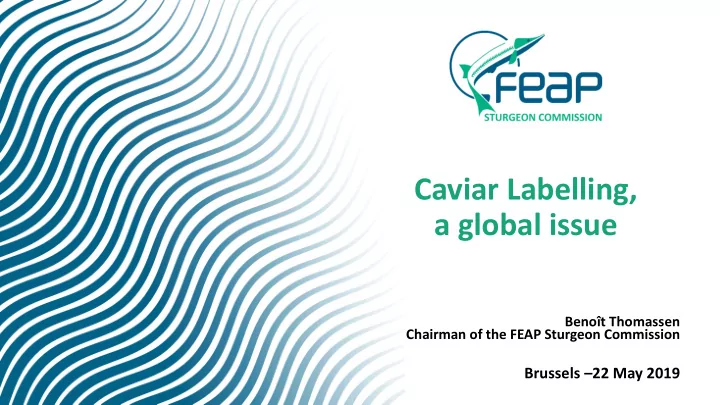

Caviar Labelling, a global issue Benoît Thomassen Chairman of the FEAP Sturgeon Commission Brussels – 22 May 2019
Caviar historical background Historicaly : • More than 90% of caviar came from Black and Caspian Seas • Because of overfishing, international trade of caviar fell under CITES in 1998 • Quotas not respected → ban on exports of « Wild » sturgeon in 2008 3500 3000 2500 2000 (t) 1500 1000 500 0 Data: WSCS 1976 1981 1986 1991 1996 2001 2006 2011 2016
Caviar labelling, the issue Facts list : • EU is the bigger market for caviar • Only CITES code as mendatory mentions on label of cans • Extremely hard to read (or understand for casual buyers) • The majority of the caviar produced outside the EU is not sold under the primary producer brand but is repacked in European facilities under an other name (which is called repacking) • Big loss of information (and misunderstandings) Why ?
Caviar labelling, the issue Not repacked caviar label : Species code Country of origin Processing plant identification number ↓ ↓ ↓ HUS / C / CN / 2017 / xxxx / yyyy ↑ ↑ ↑ Source (wild or cultivated) Year of harvest Lot identification number Repacked caviar label (same product) : Repacking plant identification number with country ID code ↓ HUS / C / CN / 2018 / FR-xxxx / yyyy ↑ ↑ Year of repacking Lot identification number (or export or re-export certificate number)
Caviar labelling, the issue Results : • No more information about the year of production and the plant of origin (only the country, if you are able to read the code !) • European consumers don’t know what they buy ! But, CMO (EU 1379/2013) in its precepts clearly states : “In order to enable consumers to make informed choices, it is necessary for them to be provided with clear and comprehensive information on, inter alia, the origin and the method of production of the products”
Caviar labelling, the issue CMO, what does it exactly say ? Art. 35 (mandatory information) : (a) the commercial designation of the species and its scientific name ; (b) the production method, in particular by the following words "... caught ..." or "... caught in freshwater ..." or "... farmed ..."; (c) the area where the product was caught or farmed , and the category of fishing gear used in capture of fisheries In application for products listed in Annex 1 (a, b, c e) BUT not for products listed in Annex 1 (h) : “Prepared or preserved fish; caviar and caviar substitutes prepared from fish eggs”
Caviar labelling, the issue What is exactly caviar ? • According to CMO Annex 1 : Prepared or preserved fish So, it means that it has been processed : ‘processing’ means any action that substantially alters the initial product, including heating, smoking, curing, maturing, drying, marinating, extraction, extrusion or a combination of those processes (852/2004) Is it the case ? Absolutely not ! • According to us : pre-packaged, salted aquaculture product And so falls under Annex I (b) Fish, dried, salted or in brine; smoked fish, whether or not cooked before or during the smoking process; flours, meals and pellets of fish, fit for human consumption
Caviar labelling, the issue Why ? + salt + salt Prepared or preserved fish (Annex 1 h) Fish, dried, salted or in brine (Annex 1 b) → CMO Art 35, only CITES labelling → Art 35, full labelling !
Caviar labelling, the issue What does it imply ? • Move “1604.31 Caviar” from CMO Annex 1 (h) to Annex 1 (b) → Caviar should follow art. 35 and label should clearly state the origin of the product ! • Or creation of a Common Marketing Standard on Caviar Labelling • FEAP also ask for the 2 dates (production and repacking) clearly appear on the cans. To be clear FEAP : • d oesn’t want to make an exception for caviar but wants fresh caviar considered as it is, not prepared or preserved fish • doesn’t want to stop extra-EU imports • doesn’t say imported caviar is of lower quality • wants European repackers stop making consumers believe that what they sell comes from Europe or Caspian Sea !
Caviar labelling, the issue Where are we now ? • AAC (Aquaculture Advisory Council) • MAC (Market Advisory Council) Still under discussion with support of the majority • Bilateral meeting with the European Commission (DG MARE) Planned
UN’s Sustainable Development Goals 1) No Poverty 10) Reducing Inequality 2) Zero Hunger 11) Sustainable Cities and Communities 3) Good Health and Well-being 12) Responsible Consumption and Production 4) Quality Education 13) Climate Action 5) Gender Equality 14) Life Below Water 6) Clean Water and Sanitation 15) Life On Land 7) Affordable and Clean Energy 16) Peace, Justice, and Strong Institutions 8) Decent Work and Economic Growth 17) Partnership 9) Industry, Innovation, and Infrastructure
Thank you for your attention
Recommend
More recommend